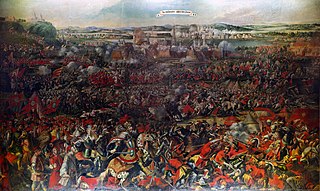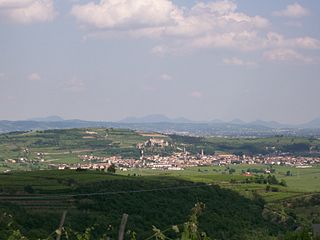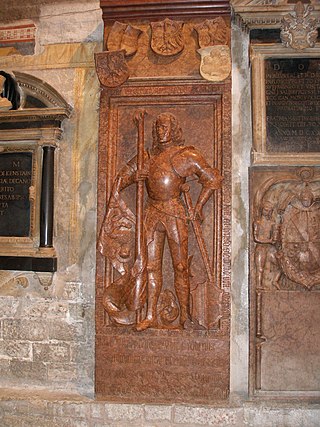
The history of Tyrol, a historical region in the middle alpine area of Central Europe, dates back to early human settlements at the end of the last glacier period, around 12,000 BC. Sedentary settlements of farmers and herders can be traced back to 5000 BC. Many of the main and side valleys were settled during the early Bronze Age, from 1800 to 1300 BC. From these settlements, two prominent cultures emerged: the Laugen-Melaun culture in the Bronze Age, and the Fritzens-Sanzeno culture in the Iron Age.

The Battle of Oudenarde, also known as the Battle of Oudenaarde, was a major engagement of the War of the Spanish Succession, pitting a Grand Alliance force consisting of eighty thousand men under the command of the Duke of Marlborough and Prince Eugene of Savoy against a French force of eighty-five thousand men under the command of the Duc de Bourgogne and the Duc de Vendôme, the battle resulting in a great victory for the Grand Alliance. The battle was fought near the city of Oudenaarde, at the time part of the Spanish Netherlands, on 11 July 1708. With this victory, the Grand Alliance ensured the fall of various French territories, giving them a significant strategic and tactical advantage during this stage of the war. The battle was fought in the later years of the war, a conflict that had come about as a result of English, Dutch and Habsburg apprehension at the possibility of a Bourbon succeeding the deceased King of Spain, Charles II, and combining their two nations and empires into one.

The Battle of Arcole or Battle of Arcola was fought between French and Austrian forces 25 kilometres (16 mi) southeast of Verona during the War of the First Coalition, a part of the French Revolutionary Wars. The battle saw a bold maneuver by Napoleon Bonaparte's French Army of Italy to outflank the Austrian army led by József Alvinczi and cut off its line of retreat. The French victory proved to be a highly significant event during the third Austrian attempt to lift the siege of Mantua. Alvinczi planned to execute a two-pronged offensive against Bonaparte's army. The Austrian commander ordered Paul Davidovich to advance south along the Adige River valley with one corps while Alvinczi led the main army in an advance from the east. The Austrians hoped to raise the siege of Mantua where Dagobert Sigmund von Wurmser was trapped with a large garrison. If the two Austrian columns linked up and if Wurmser's troops were released, French prospects were grim.

The Battle of Sacile on 16 April 1809 and its companion Clash at Pordenone on 15 April saw an Austrian army commanded by Archduke John of Austria defeat a Franco-Italian army led by Eugène de Beauharnais and force it to retreat. Sacile proved to be the most notable victory of John's career. The action took place east of the Livenza River near Sacile in modern-day Italy during the War of the Fifth Coalition, part of the Napoleonic Wars.

The Great Turkish War, also called the Wars of the Holy League, was a series of conflicts between the Ottoman Empire and the Holy League consisting of the Holy Roman Empire, Poland-Lithuania, Venice, Russia, and Habsburg Hungary. Intensive fighting began in 1683 and ended with the signing of the Treaty of Karlowitz in 1699. The war was a defeat for the Ottoman Empire, which for the first time lost large amounts of territory, in Hungary and the Polish–Lithuanian Commonwealth, as well as part of the western Balkans. The war was significant also by being the first time that Russia was involved in an alliance with Western Europe.

Georg von Frundsberg was a German military and Landsknecht leader in the service of the Holy Roman Empire and Imperial House of Habsburg. An early modern proponent of infantry tactics, he established his reputation in active service during the Italian Wars under Emperor Maximilian I and his successor Charles V.

The Battle of Zenta, also known as the Battle of Senta, was fought on 11 September 1697, near Zenta, Ottoman Empire, between Ottoman and Holy League armies during the Great Turkish War. The battle was the most decisive engagement of the war, and it saw the Ottomans suffer an overwhelming defeat by an Imperial force half as large sent by Emperor Leopold I.

The Prince-Bishopric of Trent was an ecclesiastical principality roughly corresponding to the present-day Northern Italian autonomous province of Trentino. It was created in 1027 and existed until 1802, when it was secularised and absorbed into the County of Tyrol held by the House of Habsburg. Trent was a Hochstift, an Imperial State under the authority of a prince-bishop at Trento.

The battle of Cadore, also known as the battle of Rio Secco or Rusecco, was a battle that took place near Pieve di Cadore during the opening phase of the War of the League of Cambrai, part of the Italian Wars, on 2 March 1508, opposing the Venetian armies commanded by Bartolomeo d'Alviano and those of the Holy Roman Empire under the leadership of Sixt von Trautson. The battle resulted in a decisive Venetian victory, stopping the Habsburg invasion of Cadore and allowing the Venetians to reconquer all their lost strongholds as well as invade Habsburg-ruled lands in Friuli and the Julian March, besieging Trieste and marching on Istria. This would trigger the creation of the League of Cambrai and the beginning of the War of the League of Cambrai.

The Battle of Bassano was fought on 8 September 1796, during the French Revolutionary Wars, in the territory of the Republic of Venice, between a French army under Napoleon Bonaparte and Austrian forces led by Count Dagobert von Wurmser. The engagement occurred during the second Austrian attempt to raise the siege of Mantua. It was a French victory, however it was the last battle in Napoleon's perfect military career as two months later he would be defeated at the Second Battle of Bassano, ending his victorious streak. The Austrians abandoned their artillery and baggage, losing supplies, cannons, and battle standards to the French.

During the siege of Mantua, which lasted from 4 July 1796 to 2 February 1797 with a short break, French forces under the overall command of Napoleon Bonaparte besieged and blockaded a large Austrian garrison at Mantua for many months until it surrendered. This eventual surrender, together with the heavy losses incurred during four unsuccessful relief attempts, led indirectly to the Austrians suing for peace in 1797. The siege occurred during the War of the First Coalition, which is part of the French Revolutionary Wars. Mantua, a city in the Lombardy region of Italy, lies on the Mincio River.

Baron Josef Philipp Vukassovich was a Croatian soldier who joined the army of Habsburg monarchy and fought against both Ottoman Empire and the First French Republic. During the French Revolutionary Wars, he commanded a brigade in the 1796–1797 Italian campaign against Napoleon Bonaparte. He led a division during the Napoleonic Wars and received a fatal wound in action.
The Battle of Calliano on 6 and 7 November 1796 saw an Austrian corps commanded by Paul Davidovich rout a French division directed by Claude Belgrand de Vaubois. The engagement was part of the third Austrian attempt to relieve the French siege of Mantua during the French Revolutionary Wars. The battle was preceded by a clash at Cembra on 2 November and followed by actions at Rivoli Veronese on 17 and 21 November.
The Second Battle of Bassano on 6 November 1796, saw a Habsburg army commanded by József Alvinczi fight Napoleon Bonaparte's French Army of Italy. The Austrians repulsed persistent French attacks in a struggle in which both sides suffered heavy losses. The engagement, which happened two months after the more famous Battle of Bassano, marked the first tactical defeat of Bonaparte's career and occurred near Bassano del Grappa in Northern Italy during the French Revolutionary Wars. The action was part of the third relief of the siege of Mantua during the War of the First Coalition.
Count Albert Gyulay de Marosnémethi et Nádaska or Albert Gyulai von Máros-Németh und Nádaska, born 12 September 1766 – died 27 April 1835, a Hungarian, joined the army of Habsburg Austria and fought against Ottoman Turkey. He served against the First French Republic in the Flanders Campaign and on the Rhine. Severely wounded in 1799, he survived a trepanning operation and briefly retired from military service. He returned to active service and commanded an army corps during the War of the Fifth Coalition, part of the Napoleonic Wars. He led his troops in several important battles during the Austrian invasion of Italy in 1809, including one where he was in independent command. Though appointed to command troops in 1813 and 1815, he missed combat in both campaigns. He was Proprietor (Inhaber) of an Austrian infantry regiment from 1810 until his death. The more famous Ignác Gyulay, Ban of Croatia was his older brother.

In the Battle of Caldiero or Battle of Soave or Battle of Castelcerino from 27 to 30 April 1809, an Austrian army led by Archduke John of Austria defended against a Franco-Italian army headed by Eugène de Beauharnais, the Viceroy of the Kingdom of Italy. The outnumbered Austrians successfully fended off the attacks of their enemies in actions at San Bonifacio, Soave, and Castelcerino before retreating to the east. The clash occurred during the War of the Fifth Coalition, part of the Napoleonic Wars.

Roberto Sanseverino d'Aragona was an Italian condottiero, count of Colorno from 1458 to 1477 and count of Caiazzo from 1460 until his death in 1487. Highly esteemed man of arms, veteran of numerous battles, he was one of the greatest leaders of the Italian Renaissance.

The Battle of Tápióbicske was a battle in the Spring Campaign of the Hungarian War of Independence (1848–1849), fought on 4 April 1849 between the Austrian Empire and the Hungarian Revolutionary Army. The Habsburg forces consisted of the I Corps of the Imperial Army led by Lieutenant Field Marshal Josip Jelačić. The Hungarians deployed I and III Corps led by General György Klapka and General János Damjanich respectively. Although initially the careless soldiers of the I. corps were put to flight by the Croatian and Austrian soldiers, after entering in their trap, the Hungarians were victorious, thanks to the intervention of the III. corps, and the main Hungarian armies could advance towards the Hungarian capitals, forcing the Austrian high commander, Field Marshal Alfred I, Prince of Windisch-Grätz fight a decisive battle at Isaszeg, which would decide the fate of Central and Western Hungary until the intervention of the Russian forces on the Habsburg side in June 1849.

The Battle of Pered, fought on 20–21 June 1849, was one of the battles which took place in the Summer Campaign of the Hungarian War of Independence from 1848 to 1849, fought between the Hungarian Revolutionary Army and the Habsburg Empire helped by Russian troops. The Hungarian army was led by General Artúr Görgei, while the imperial army by Lieutenant field marshal Julius Jacob von Haynau. After several preliminary minor battles of the Hungarian and Austrian troops along the Vág river, in which the attacking Hungarians could not achieve success, Görgei took the command of his troops, and after receiving reinforcements, on 20 June, put his troops to attack again towards West. Although the II. Hungarian army corps occupied in heavy fights the village of Pered, the other two corps were unsuccessful, and could not advance. The angered Görgei removed the commander of the III. corps, General Károly Knezić because of his inactivity, and Colonel Lajos Asbóth, the commander of the II. corps who, in contrast to Knezić, was the only commander who accomplished his duties. While Knezić's place was taken by Colonel Károly Leiningen-Westerburg, who was a great choice, Asbóth's place was taken by Colonel József Kászonyi, who was an explicitly bad choice. Haynau, who on the first day of the battle was moving the bulk of his troops to cross the Danube to start an attack on its southern bank, sent three of his corps, which were still on the northern bank, to repel the Hungarian forces. The two Austrian and one Russian corps started their attack on 21 June and forced the Hungarians to retreat from Pered and Zsigárd, which forced Görgei to order his troops to retreat from the battlefield.
Guido de' Rossi was an Italian condottiero.
















